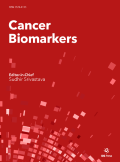Authors: Karataş, Fatih | Acat, Murat | Karatas, Hatice Gulsah | İnci, Fatih | Dikiş, Özlem Sengören
Article Type:
Research Article
Abstract:
BACKGROUND: Despite Non-small cell lung cancer (NSCLC) ranks among the most deadly cancers worldwide, and currently, apart from a low percentage, targetable molecules have not been identified in its etiopathogenesis. The relationship between the proteoglycans decorin and biglycan, which are present in the extracellular matrix of cells, and transforming growth factor Beta-1 (TGF-B1), has been shown in many cancers. We investigated the significance of these molecules in NSCLC. METHODS: Fasting serum levels of decorin, biglycan, and TGF-B1 were obtained from 48 newly diagnosed NSCLC patients and compared with those of 48 adult control subjects matched for
…age and demographics. Demographic data, baseline laboratory values, and ELISA results were compared between the groups. RESULTS: The median age was 65(39–83) similar in both groups. There was no relation between demographic and clinical parameters and the levels of decorin, biglycan, and TGF-B1 in the NSCLC group. However, in comparison to the control group, NSCLC patients had significantly higher levels of biglycan (42.55 ± 27.40 vs. 24.38 ± 12.05 ng/mL, p = 0.026) and TGF-B1 (15.55 ± 9.16 vs. 10.07 ± 7.8 pg/mL, p = 0.001), while decorin levels were significantly lower (6.64 ± 1.92 vs. 10.28 ± 3.13 ng/mL, p = 0.002). In the multivariate regression analysis; Decorin < 8.13 ng/mL (OR, 10.96; 95% CI: 3.440–34.958), current smoking (OR, 3.81; 95% CI: 1.320–10.998), COPD (OR, 43.6; 95% CI: 2.082–913.081), and lower BMI (OR, 1.22; 95% CI: 1.070–1.405, p = 0.003) were identified as independent predictive markers for NSCLC diagnosis. CONCLUSION: The decreased serum decorin level is an independent marker for NSCLC. Further studies are needed to investigate the prognostic significance of decorin on survival and its potential as a target in treatment.
Show more
Keywords: Non small cell, lung cancer, decorin, biglycan, TGF-B1
DOI: 10.3233/CBM-230238
Citation: Cancer Biomarkers,
vol. Pre-press, no. Pre-press, pp. 1-6, 2023





